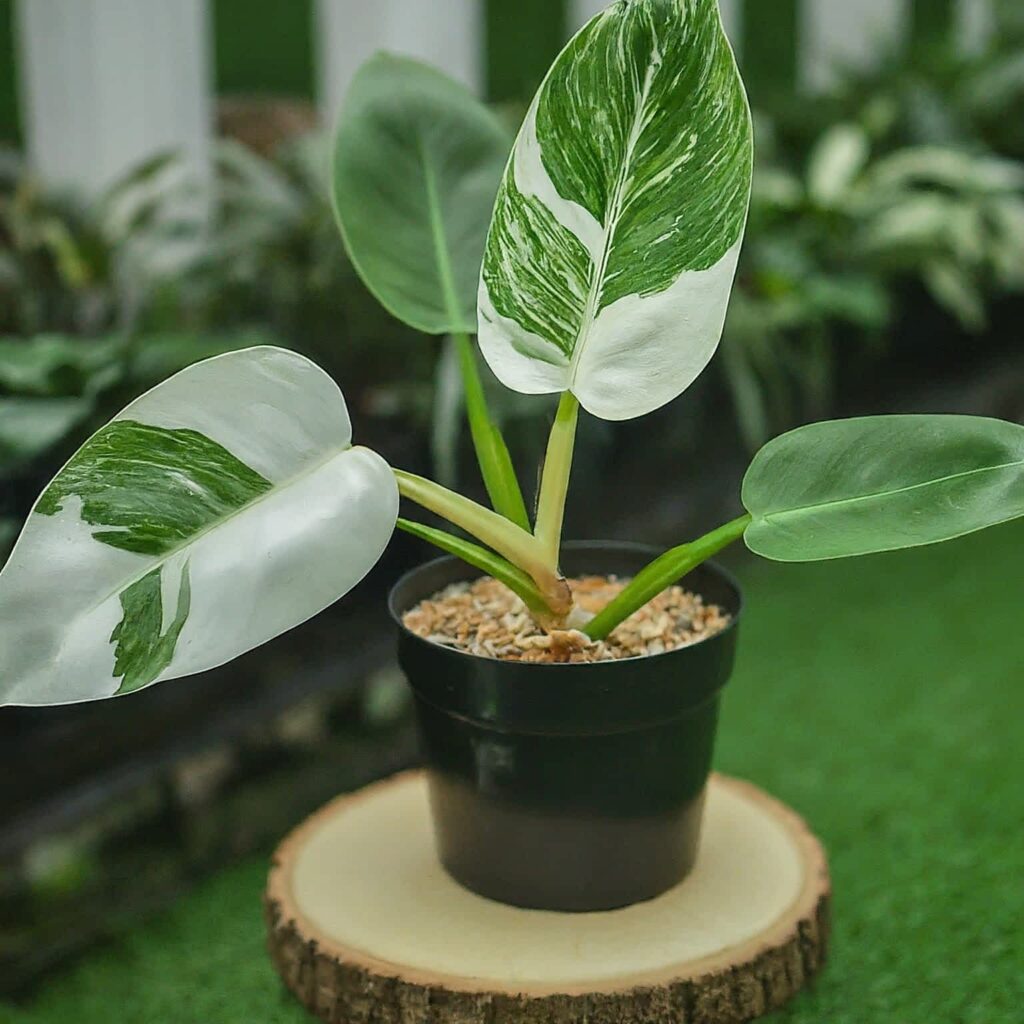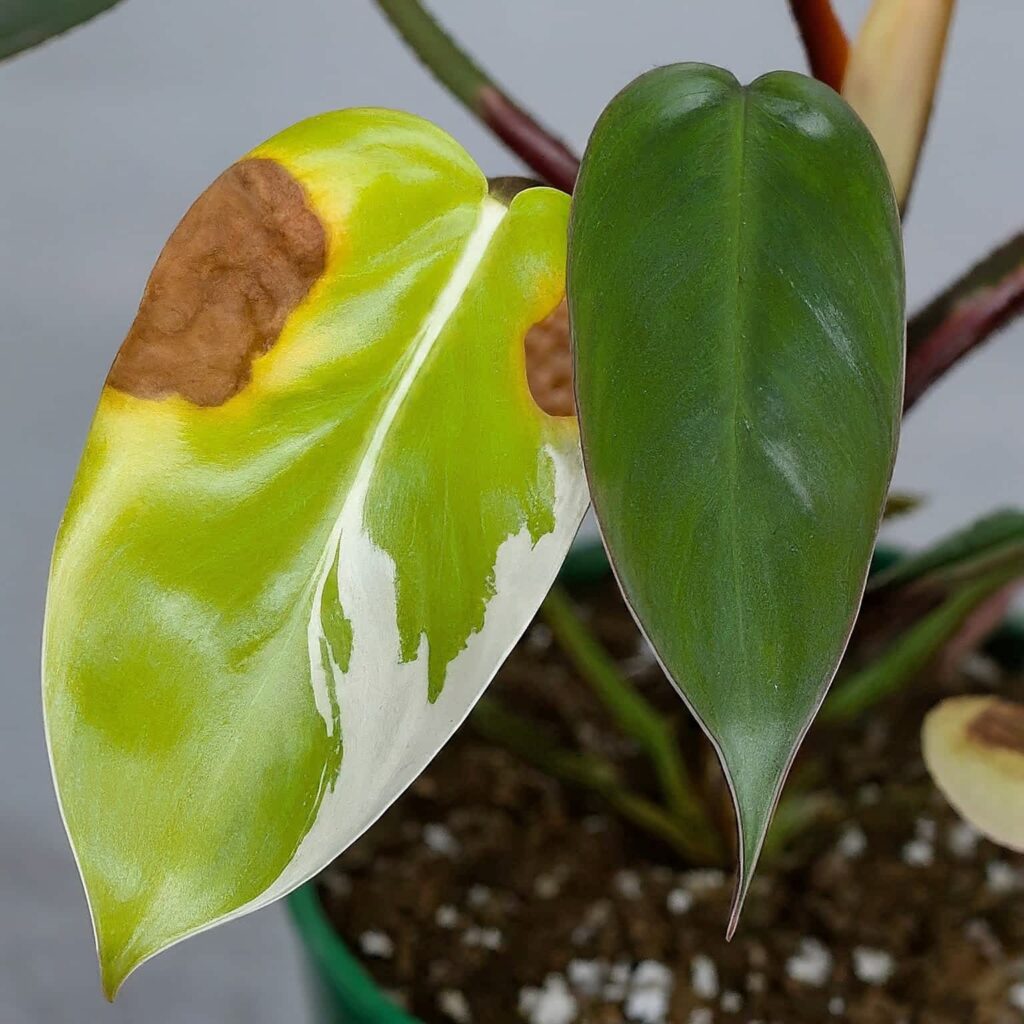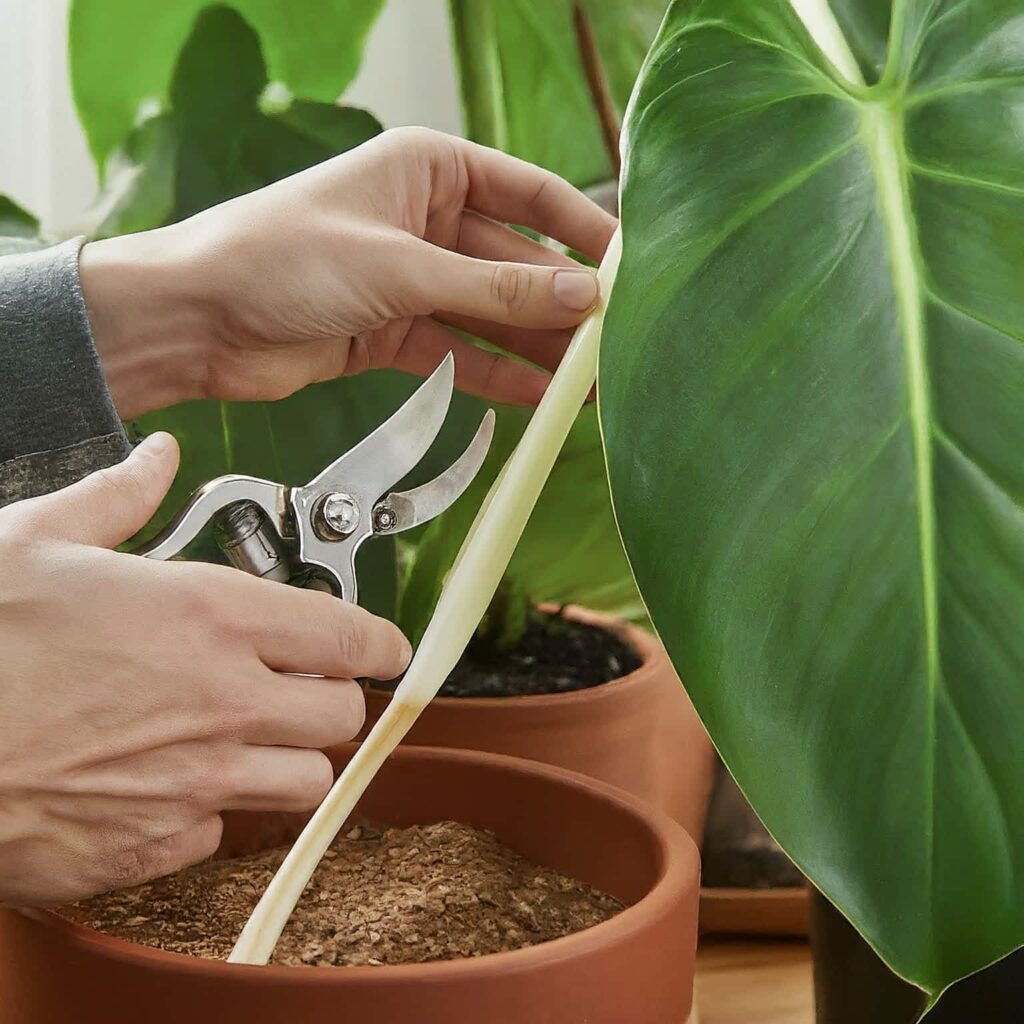Welcome to the wonderful world of the White Knight Philodendron! If you’re new to gardening and looking to add a touch of elegance to your indoor space, this striking plant is a fantastic choice.
The White Knight Philodendron isn’t your average houseplant.
With its captivating, variegated leaves boasting creamy white splashes against a backdrop of emerald green, this philodendron variety is a true conversation starter. But beyond its stunning looks, the White Knight is surprisingly easy to care for.
Jump to a section:
White Knight Philodendron Background Information

The White Knight Philodendron has quickly become a favorite among indoor plant enthusiasts due to its striking appearance and relatively low maintenance requirements.
- Leaves: The leaves of the White Knight Philodendron are heart-shaped and feature a striking mix of green and white variegation. Some leaves may also display hints of pink.
- Stems: The plant’s stems are typically dark green to purple, providing a beautiful contrast to the leaves.
- Growth Habit: This philodendron is a climbing plant, which means it will benefit from a moss pole or trellis to support its upward growth.
- Size: Mature plants can reach heights of up to 3 meters, making them a great choice for adding height and interest to your indoor garden.
Origin and History
The White Knight Philodendron hails from the tropical rainforests of South America, where it thrives in the warm, humid environment of the forest understory.
These lush rainforests, rich in biodiversity, provide the perfect conditions for the White Knight to flourish, climbing trees and other structures to reach the dappled sunlight above.
Discovered and popularized by plant enthusiasts, this philodendron has made its way into homes and gardens around the world. Its striking variegation and relatively easy care have earned it a special place in the hearts of indoor gardeners.
Over time, selective breeding has enhanced its variegation patterns, making each plant unique.
Despite its tropical origins, the White Knight Philodendron has adapted well to indoor environments, bringing a touch of the exotic into our living spaces and continuing the legacy of its rainforest roots.
Facts Table
| Feature | Description |
| Common Name | White Knight Philodendron |
| Botanical Name | Philodendron sp. |
| Family | Araceae |
| Origin | South America |
| Light Requirement | Bright, indirect light |
| Watering | Moderate, allow top inch of soil to dry out |
| Humidity | High, thrives in humid environments |
| Temperature | 65-80°F (18-27°C) |
| Soil | Well-draining, rich in organic matter |
| Growth Habit | Climbing |
| Mature Size | Up to 3 meters |
Natural Habitat
In its natural habitat, the White Knight Philodendron grows in the shaded understory of tropical rainforests, climbing up trees and other structures to reach the dappled sunlight above.
This environment is characterized by high humidity, warm temperatures, and rich, well-draining soil. The constant moisture in the air and the forest floor’s nutrient-rich composition create ideal conditions for the White Knight Philodendron to thrive.
In addition to the high humidity, the plant benefits from the consistent temperatures found in these regions, typically ranging between 65-80°F (18-27°C).
When cultivating this plant at home, it is a good idea to mimic these conditions to help it thrive.
For example, you can create a similar microclimate indoors using humidifiers and well-draining soil mixes, and maintaining warm temperatures. This will ensure that your White Knight Philodendron can flourish just as it would in its native habitat.
How to Grow and Care for White Knight Philodendron

Caring for a White Knight Philodendron involves understanding its natural preferences and creating a similar environment in your home.
Here’s a detailed guide to help you get started, ensuring your plant not only survives but thrives.
Quick Care Tips
- Place your White Knight Philodendron in bright, indirect light.
- Keep temperatures between 65-80°F (18-27°C).
- Maintain high humidity levels.
- Use well-draining, nutrient-rich soil.
- Does the top inch of soil feel like a desert? Time to quench your plant’s thirst!
- Fertilize monthly during the growing season.
- Repot every 1-2 years.
Light
The White Knight Philodendron prefers to bask in the gentle glow of bright, indirect sunlight.
As such, it is always best to place your plant near a window with filtered light or in a room with plenty of ambient light. North or east-facing windows are ideal because they provide sufficient light without exposing the plant to harsh midday sun.
If your home lacks natural light, consider using a grow light to supplement. In doing so, be cautious not to place the plant too close to the light source, as this can also cause leaf burn.
Temperature and Humidity
As stated earlier, this plant prefers warm temperatures between 65-80°F (18-27°C). This means you should avoid placing it near drafts, air conditioning vents, or heaters because sudden temperature changes can stress the plant.
High humidity is crucial for the White Knight Philodendron. Always try to maintain humidity levels of 60% or higher.
Consider using a humidifier, placing a tray of water near the plant, or grouping it with other humidity-loving plants. Another method is to occasionally mist the leaves, but avoid overdoing it to prevent fungal issues.
Soil
A well-draining, nutrient-rich soil mix is crucial for the health of your White Knight Philodendron.
A good mix includes potting soil, perlite, and orchid bark or coco coir. This winning combination provides the perfect balance: excellent drainage to prevent root rot, and just the right amount of moisture to keep your plant thriving.
You can also add a bit of activated charcoal to the mix to improve aeration and prevent root rot.
The ideal soil pH for this plant is slightly acidic to neutral, around 5.5 to 7.0. Avoid using heavy, clay-based soils that retain too much moisture, as this can lead to root rot.
Water
Water your White Knight Philodendron when the top inch of the soil feels dry to the touch. Overwatering can lead to root rot, so it’s essential to let the soil dry out slightly between waterings.
- As your White Knight Philodendron puts on its summer growth spurt, it might get thirstier, so keep an eye on the soil moisture.
- As winter approaches and your White Knight Philodendron enters its resting phase, ease off on the watering can.
- Your White Knight wouldn’t appreciate an icy bath! As such, you should opt for room temperature water to keep its roots happy.
- Ensure that the pot has drainage holes to prevent water from sitting at the bottom, which can cause root rot.
Feeding/Fertilizer
Feed your White Knight Philodendron with a balanced, water-soluble fertilizer every month during the growing season. This provides the essential nutrients needed for healthy growth and vibrant foliage.
In the dormant season, you can cut back on fertilizing to avoid overfeeding.
Choose a fertilizer with an N-P-K ratio of 20-20-20 or 10-10-10, and dilute it to half the recommended strength to prevent fertilizer burn.
Want to give your plant a healthy and eco-friendly pick-me-up? Consider organic options like fish emulsion or worm castings, as these are packed with beneficial nutrients that promote vibrant growth.
To help your White Knight Philodendron display its best variegation, you may want to feed it with a homemade nitrogen fertilizer.
Repotting
Repot your White Knight Philodendron every 1-2 years or when it becomes root-bound.
Choose a pot that is one size larger than the current one and refresh the soil with a well-draining mix. Repotting gives the plant room to grow and ensures it has access to fresh nutrients.
For a smooth transition, repot your White Knight Philodendron during its growth spurt in spring or early summer. This allows it to focus its energy on establishing itself in the new pot.
Carefully remove the plant from its current pot, gently loosen the root ball, and trim any dead or damaged roots before placing it in the new pot with fresh soil.
Deadheading
Deadheading, or removing spent leaves, helps your plant maintain its appearance and focus its energy on new growth.
Simply trim off any yellow or damaged leaves with clean scissors or pruning shears. This not only keeps your plant looking its best but also prevents potential pest infestations and disease.
To maintain your White Knight Philodendron’s stunning looks, keep an eye out for yellowing or dead leaves. Removing them promptly encourages healthy new growth and prevents them from draining the plant’s energy.
Pruning
Pruning is essential to keep your White Knight Philodendron in shape and encourage bushier growth. Regular pruning also helps to control the size of the plant, making it more manageable for indoor spaces.
- For a controlled and healthy prune, grab some sharp shears and make clean cuts on the stem just above a node. Nodes are those little bumps where new growth often emerges.
- Use sterilized shears as they help prevent bacteria and diseases from jumping from one plant to another during pruning.
- Trim back any leggy or unruly stems, and remove any leaves that show signs of disease or pests.
Winter Care
During the winter months, your White Knight Philodendron will enter a dormant phase.
Reduce watering and stop fertilizing during this time. Plus, keep the plant in a warm, humid environment, and avoid placing it near cold drafts or heating vents.
If the air in your home becomes too dry due to heating, consider using a humidifier to maintain adequate humidity levels.
Ensure the plant still receives adequate light, and if necessary, use grow lights to supplement natural light.
Pest and Disease Control
Like all houseplants, the White Knight Philodendron can be susceptible to pests and diseases. However, with proper care and regular monitoring, you can keep your plant healthy and pest-free.
Common pests that might attack your houseplant include spider mites, mealybugs, and aphids.
If you notice any of these pests, treat your plant with insecticidal soap or neem oil. Also, you may want to explore other natural pest control methods to protect your plant.
Ensure you thoroughly cover the affected areas and repeat the treatment as needed.
Regularly inspecting your plant for signs of pests can help you catch and address infestations early.
To prevent diseases, avoid overwatering and ensure your plant has good air circulation.
You can manage fungal issues like root rot and leaf spot by adjusting your watering routine and keeping the plant’s environment clean.
If you notice signs of disease, such as discolored or wilting leaves, isolate the affected plant to prevent the spread to other plants.
How to Manage the Common Problems With White Knight Philodendron

Even with the best care, you may encounter some issues with your White Knight Philodendron.
Here’s how to tackle the most common problems.
Yellowing/Discolored Leaves
Yellow or discolored leaves can indicate overwatering or poor drainage.
Check the soil and adjust your watering schedule as needed. Ensure the pot has proper drainage holes and consider repotting with a well-draining soil mix.
Yellowing leaves can also be a sign of nutrient deficiencies, so ensure you’re providing balanced fertilization.
Brown/Crispy Leaves
Brown or crispy leaves can result from low humidity, underwatering, or too much direct sunlight.
Increase humidity levels, water consistently, and move the plant to a spot with indirect light.
Brown tips may also indicate over-fertilization, so check your feeding routine and adjust accordingly.
Light Green, Wilted Leaves
Light green, wilted leaves often indicate a nutrient deficiency.
Feed your plant with a balanced fertilizer and ensure it’s getting enough light and water.
If the leaves are also drooping, it might be a sign of underwatering, so check the soil moisture and adjust your watering schedule.
How to Propagate White Knight Philodendron

Propagating your White Knight Philodendron is a rewarding way to expand your collection or share the plant with friends.
You have two options to multiply this plant: from stem cuttings and via air layering.
Stem Cuttings
- Select a Healthy Stem: Look for a step with at least two nodes – these are the magical spots where roots and new leaves will sprout from, ensuring a successful propagation adventure.
- Cut the Stem: Using clean, sharp scissors or pruning shears, cut just below a node.
- Remove Lower Leaves: Remove the leaves from the lower part of the cutting, leaving a few at the top.
- Prepare the Cutting: Dip the cut end in rooting hormone to encourage root growth.
- Plant the Cutting: Place the cutting in a pot filled with a well-draining soil mix. Water it lightly and create a mini greenhouse by covering the pot loosely with a plastic bag.
- Provide Care: Place the pot in a warm, bright spot with indirect light. Keep the soil moist but not waterlogged.
Patience is key! It usually takes a few weeks for roots to form on your White Knight Philodendron cutting.
Air Layering
- Select a Stem: Choose a healthy, mature stem on the plant.
- Make a Cut: Make a small, upward cut on the stem, just below a node. Avoid severing the stem completely.
- Insert a Toothpick: Insert a toothpick into the cut to keep it open.
- Apply Moist Sphagnum Moss: Wrap moist sphagnum moss around the cut area.
- Cover with Plastic: Put plastic wrap around the moss to keep it in place and maintain humidity.
- Wait for Roots: Check the moss periodically to ensure it stays moist. In a few weeks, you’ll hopefully see root development.
- Cut and Plant: Once roots are visible through the moss, cut the stem below the new root system and plant it in a pot with well-draining soil.
Check out this video about propagating the White Knight Philodendron:
Conclusion
The White Knight Philodendron is a stunning addition to any indoor garden, offering beautiful variegated foliage and a relatively easy care routine.
Follow the tips and guidelines in this guide to grow a healthy, thriving White Knight Philodendron plant that adds a touch of elegance to your home.
FAQs
Is Philodendron White Knight rare?
Yes, the Philodendron White Knight is considered rare and highly sought after by plant collectors due to its unique variegation and striking appearance.
White Knight vs White Wizard: What’s the difference?
The White Knight Philodendron vs White Wizard debate often centers on their variegation patterns. The White Knight typically has more pronounced white variegation, while the White Wizard features more subtle, creamy-white streaks.
How tall does White Knight Philodendron get?
The White Knight Philodendron can grow up to 3 meters tall. When growing it indoors, you can control its height through regular pruning and proper care.
Can Philodendron take full sun?
No, Philodendron White Knight prefers bright, indirect light. Direct, intense heat can scorch the leaves, hindering the plant’s overall health.
How often should I water White Knight?
Water your White Knight Philodendron when the top inch of soil feels dry. This typically means watering once a week, but frequency can vary based on environmental conditions.

